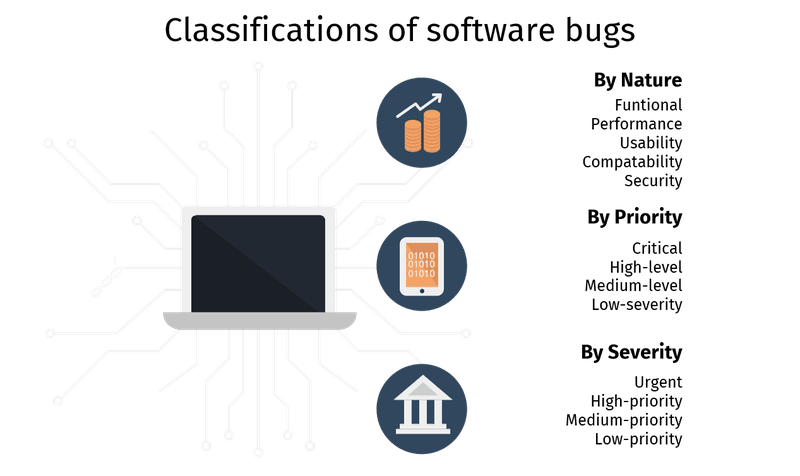In agile software development, software testing is a continuous and involved process. To learn and understand more about Quality Assurance in software testing, you can check out Polyuno's Beginner's Guide to Quality Assurance. There are many different software types in the industry, and any experienced software developer must be aware of the different kinds of bugs that exist within software.
This article discusses the different types of bugs in software development: how they can be classified and why they need to be organized.
What is a software bug?
A software bug is a problem, failure, error, or fault that results in a computer or software system crashing or failing.
Wikipedia says that,
A software bug is a flaw, error, or fault in a computer system or program that causes it to perform incorrectly or unexpectedly or produce unintended results.
The history behind why a software defect is called a bug is fascinating. One of the earliest pioneers of computer systems, Grace Hopper, experienced a malfunction is one of the earliest versions of an electromechanical computer. Upon further inspection, she traced the source of the malfunction to a moth that was stuck inside the computer. From here, the term "bug" was established for any computer system or software defects and malfunctions.
What is software testing?
Testing is the process of distinguishing a particular problem or problems during a software production. A person who does functionality testing and flows information to the developer's teams is a tester.
A tester team finds out application bugs within a specific timeframe. Then, the testing team presents the list to the system developers. They then take care of the product errors before it is ready to use by an end-user.
What are the types of bugs in software testing?
Software bugs are divided into three board categories, under which we have several types of bugs. Bugs are classified by-
- Nature
- Priority
- Severity
Classifications for bugs under the broad categories of priority and severity are already present in systems. However, adding a classifier for bugs by nature will help speed up the process of fixing bugs.

Software Bugs by nature
There are five subcategories under the by nature classification-
- Functional
- Performance
- Usability
- Compatibility
- Security
Functional bugs
Errors are considered functional defects or functional bugs when the software refuses to work according to the functional requirements. Functional testing is performed to discover the presence of such errors.
Performance bugs
Performance bugs are defects that hamper a software's performance. This can be related to the speed, response time, overall stability, and resource consumption of the software. And, yes, these types of defects are discovered through performance testing. An example of a performance bug is when a system's loading time or response time is a lot longer than that mentioned in the requirements.
Usability bugs
Usability defects are related to the ease-of-use of an application. A software/ application/ system needs to be well designed with its content placed in the right position and in the correct order to maximize the user experience and over usability.
Compatibility bugs
Systems with compatibility defects are incapable of performing uniformly on different operating systems, hardware, browsers, and specific network configurations. Software testers perform compatibility testing to discover the presence of any such bugs.
Security bugs
Security bugs or security defects are the deficiencies that may result in a potential security attack. Security testing is perhaps the test that is performed most often.
Software bugs by severity
Software bugs are classified and placed into classes of severity based on overall technical effect. We have classified software bugs into four separate levels of severity-
- Critical
- High-level
- Medium- severity
- Low-severity
Critical defects
This bug type usually blocks the entire system or module's functionality, and further testing becomes impossible without solving this first. A typical example of a critical defect can be a webpage's server returning an error message on any attempts at logging in.
High-level defects
High-level defects have adverse effects but are slightly less damaging than critical bugs. They tend to impact an application's fundamental functionality and cause the application to behave very differently from the stated requirements. For example- an email service refuses to let you enter cc and bcc recipients for your email.
Medium-severity defects
Medium-severity bugs affect the apps' minor-level functionality and cause them to function differently from their stated requirements. For example, a broken link on the Terms and Conditions page is a medium-severity defect.
Low-severity defect
These are the least damaging bugs out of the four levels and primarily affect the application's user interface (UI). For example, the color of the header on the webpage is different than the intended color.
Software bugs by priority
Software bugs are categorized by priority based on their overall business impression. Defects are divided into four categories based on priority-
- Urgent
- High-priority
- Medium-priority
- Low- priority
Urgent defects
Urgent bugs must be treated within 24hours of being reported. Usually, critical defects also fall under the urgent category. However, this isn't always the case. For example, a spelling mistake in the company's web page's loading page may not have a severe technical effect. It does have a strong business impression, which is why it is categorized as an urgent defect.
High-priority defects
These bug types must be dealt with before an upcoming update to meet the exit criteria. For example, a user cannot move from the home page to another page after having logged in.
Medium- priority defects
Medium-priority bugs can be fixed after an upcoming release or update.
Low-priority defects
The application will meet exit criteria even if low-priority defects have not been fixed. However, they usually need to be fixed before the app is made available to the masses. Examples of such defects include little things such as alignment, typos, etc.
The need for classifying software bugs
The primary reason software bug classification is needed is to streamline the entire software testing process and produce top-notch applications in the shortest possible time. The classification helps with the overall organization within the developers' team and improves its efficiency.
The severity and priority of defects also affect the quality of the product being produced and need to be fixed at different development stages. Having classifications for each type of bug means that the testing team knows exactly when and what needs to be done to improve the defect.
If you feel like you need to consult someone on the process of setting up classifications for software bugs, please contact Polyuno.




